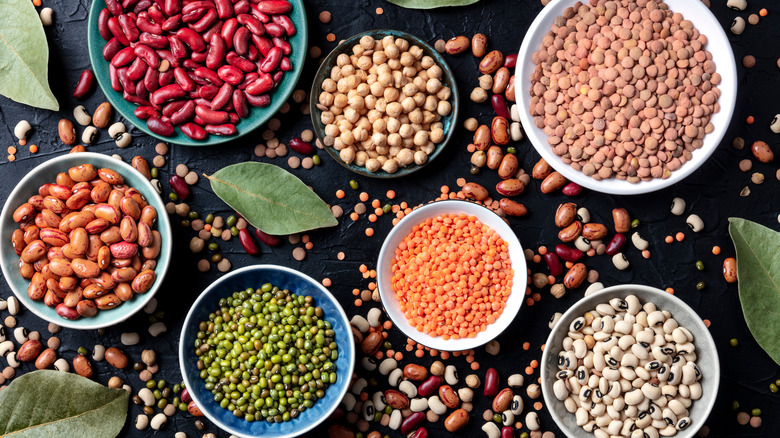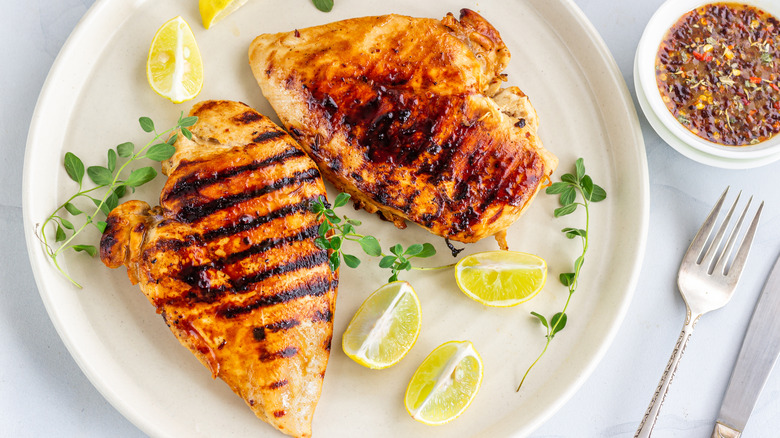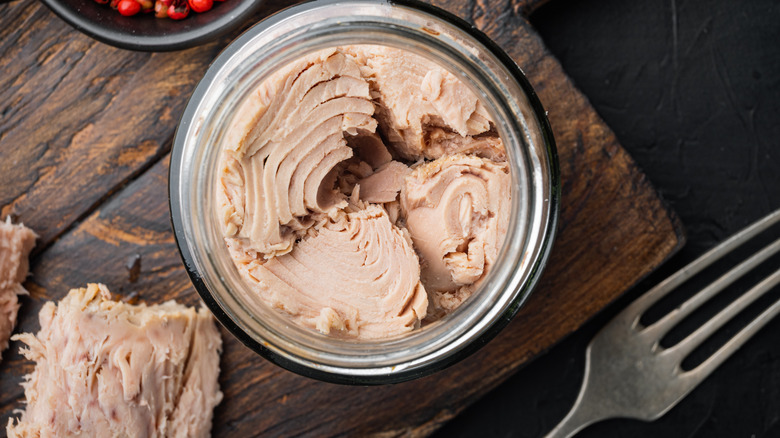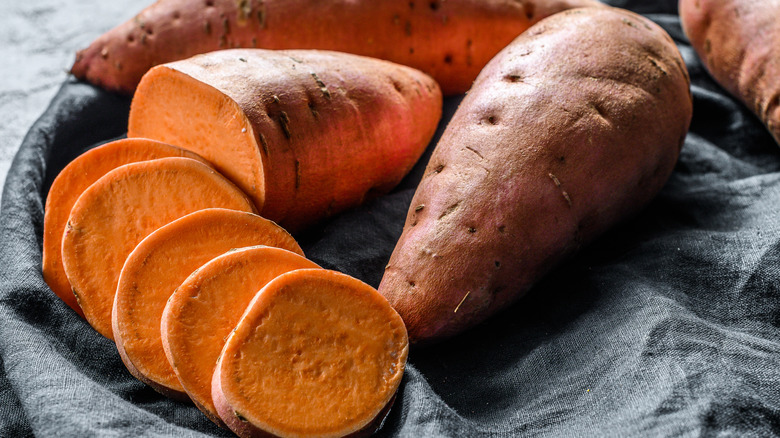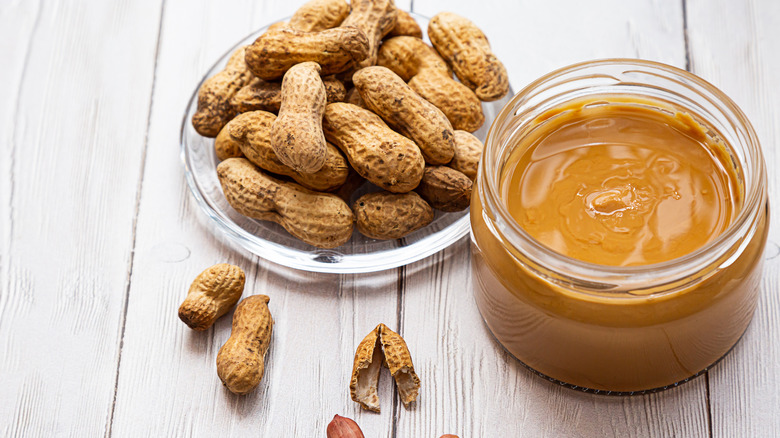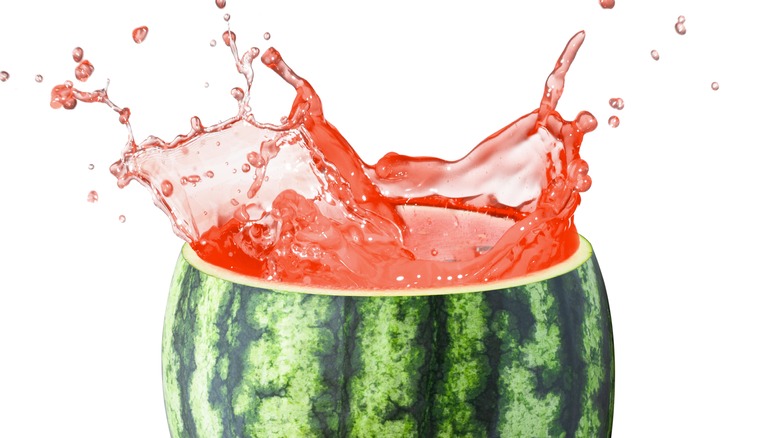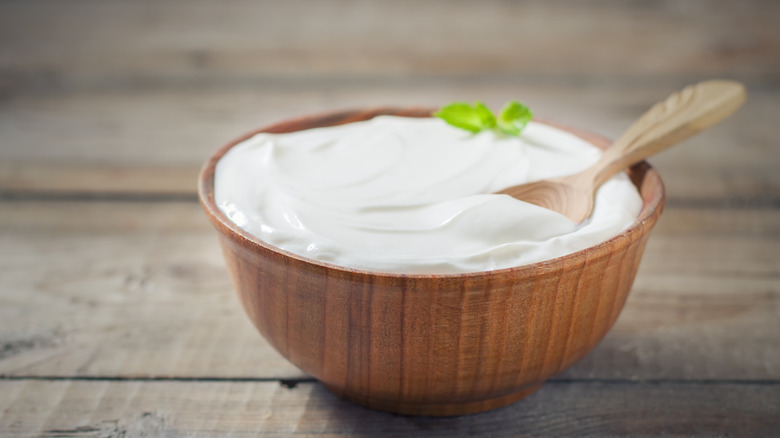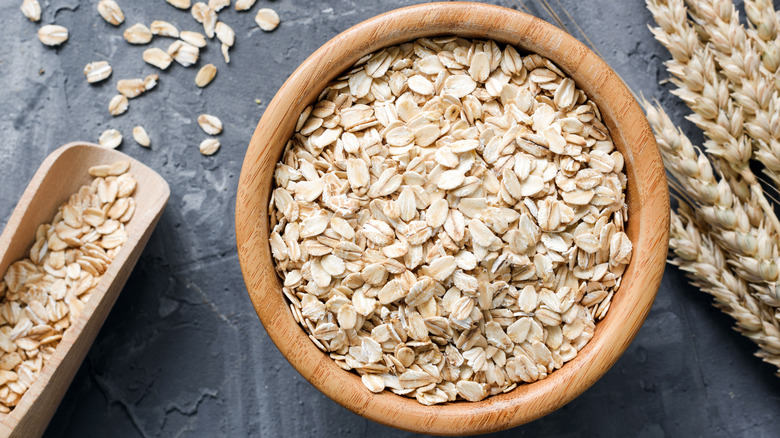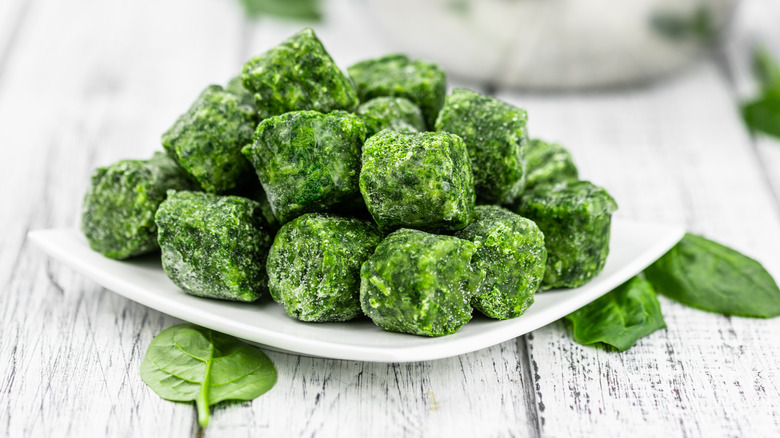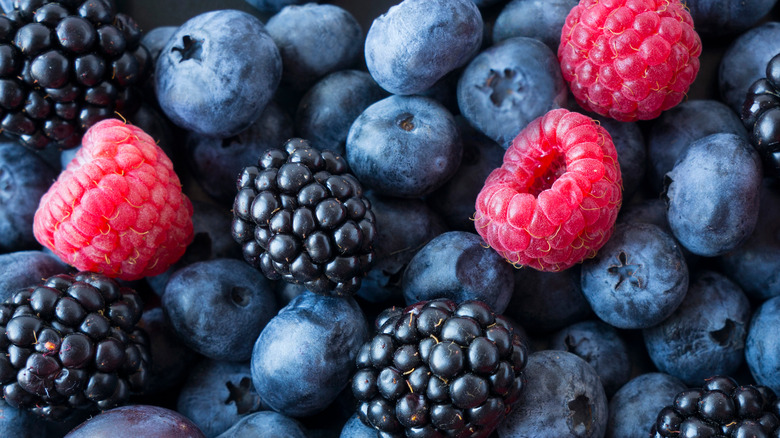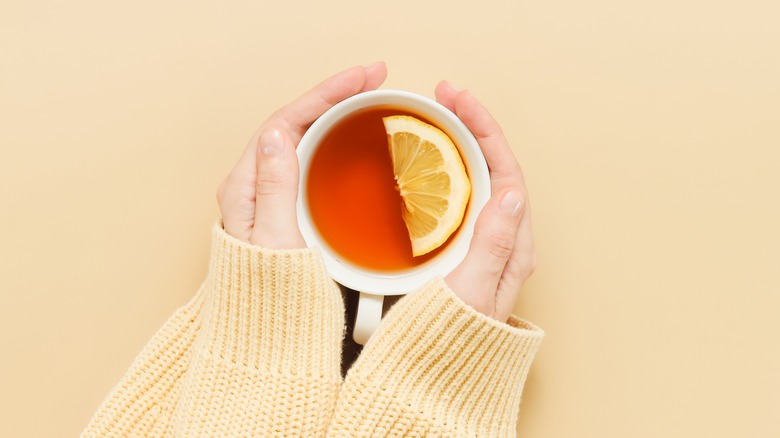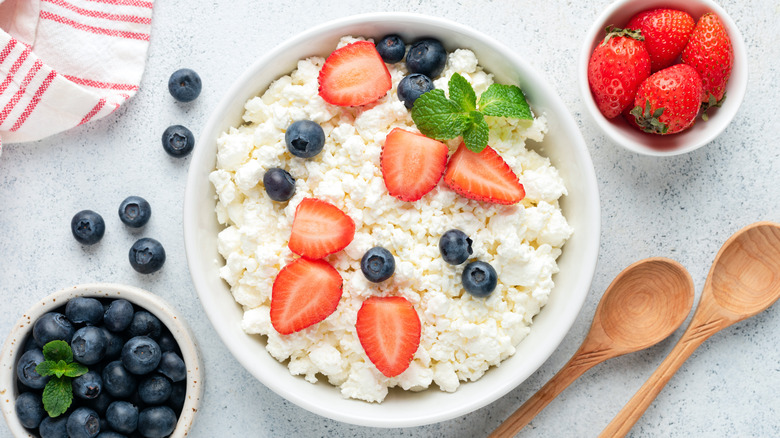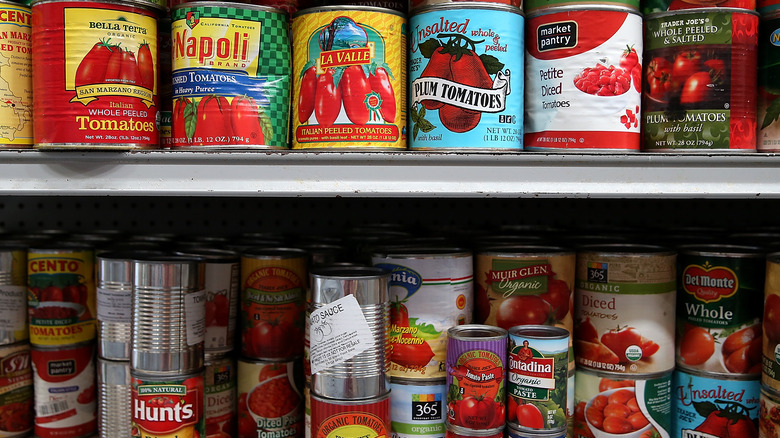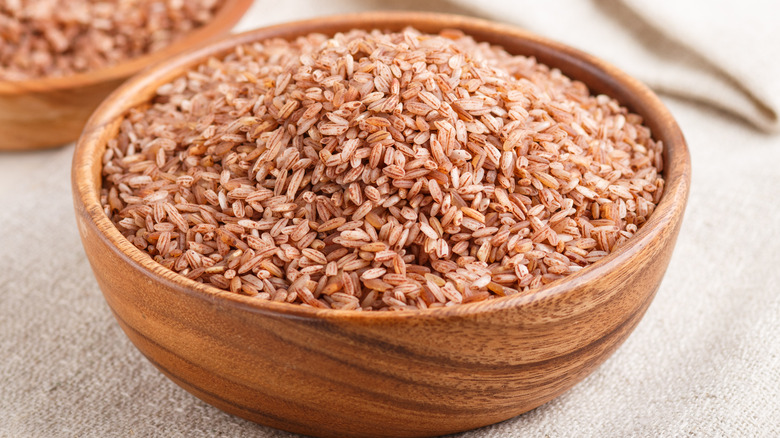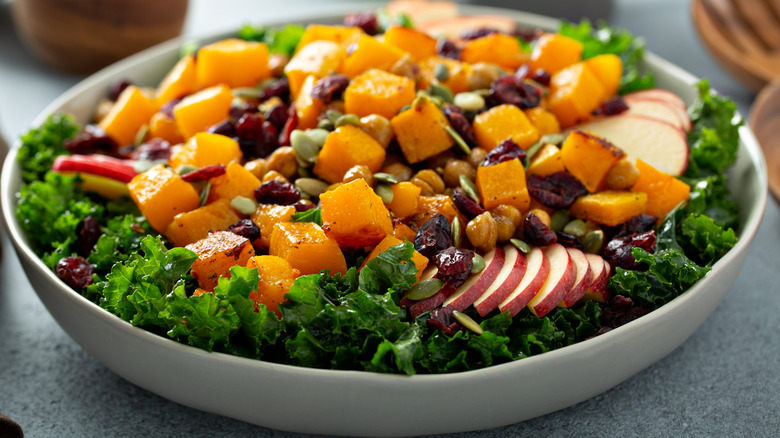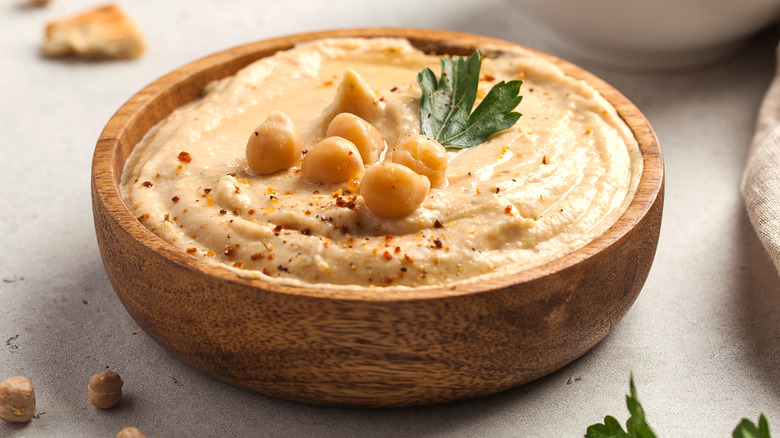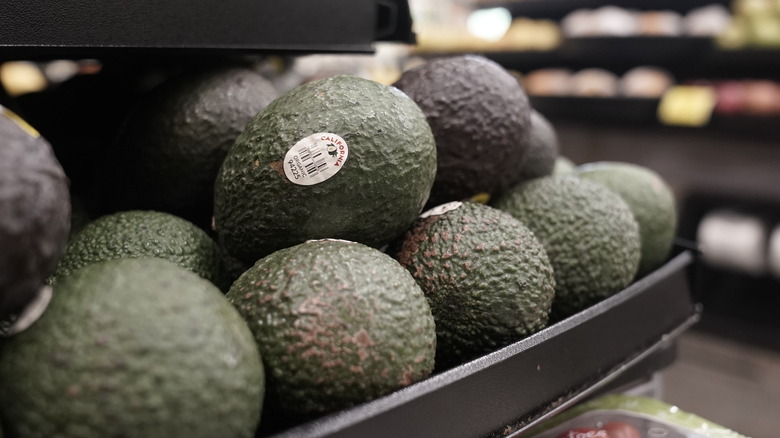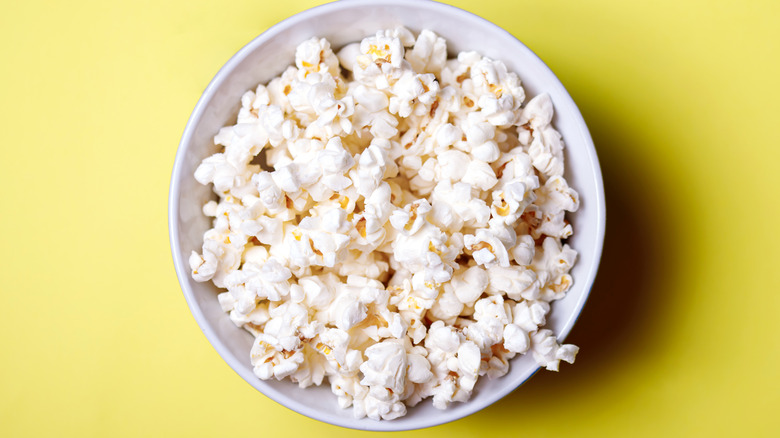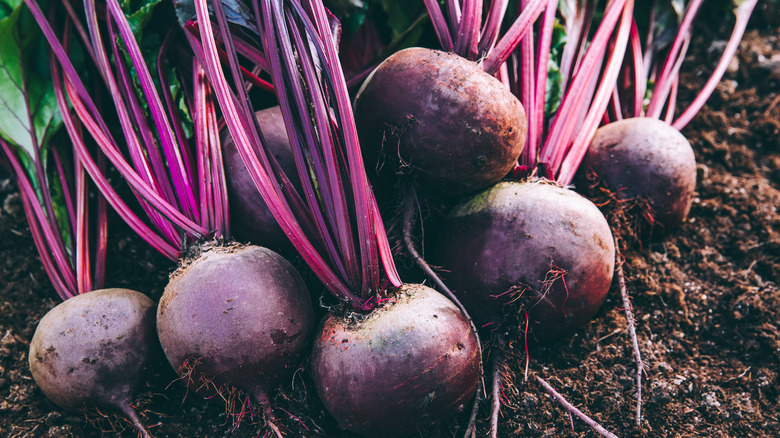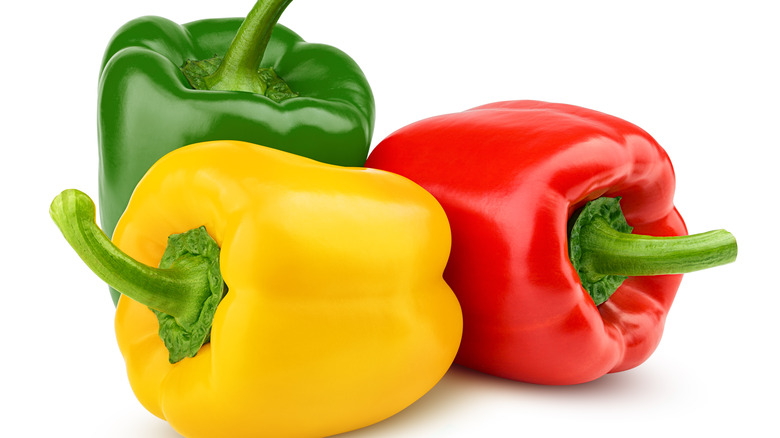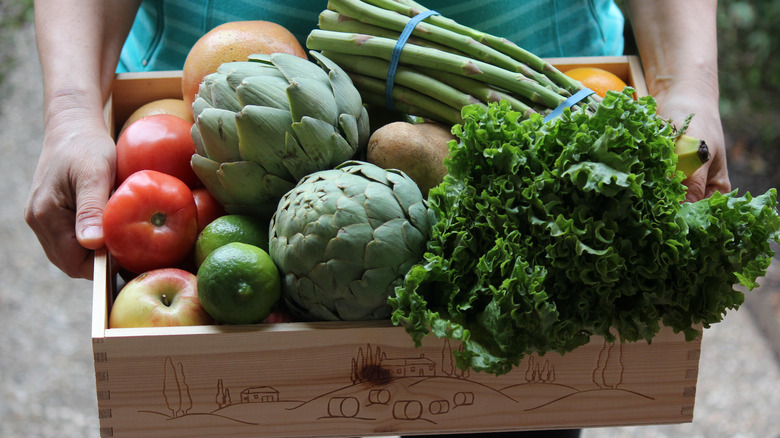Healthy Foods You Can Afford On A Budget
According to the 2020 State of Food Security and Nutrition in the World (SOFI) report, more than 3 billion people worldwide cannot afford a nutritious diet that meets global guidelines, while as many as 1.5 billion people can't even afford nutritional basics.
The World Health Organization explains that a healthy diet for the average adult consists of at least five servings of fruits and vegetables, less than five grams of salt, less than 50 grams of free sugars, and less than 30% of calories from fat. According to TuftsNow, meeting these requirements for a healthy diet is challenging for many families worldwide because many ingredients needed for one — like fresh fruit and veggies — are more expensive to grow and produce.
However, you might be surprised by how little you can spend at the grocery store and still end up with healthy ingredients. USDA research even shows that in general, healthy foods cost less than less healthy foods in terms of price per edible weight and price per average portion. Follow along to learn what budget-friendly foods to add to your shopping cart.
Beans might reduce the risk of some cancers
With so many nutritious beans to choose from, there's no excuse not to add these superfoods to your diet. Not a fan of chickpeas? Give lima beans a try. Not loving navy beans? Add black beans to your soup or chili instead.
Beans should become a staple ingredient in your pantry. According to WebMD, their concentration of natural chemicals called phytonutrients makes them a powerhouse, even potentially lowering your risk for some cancers like breast and prostate cancer. Beans can also lower bad cholesterol and improve digestion. While most beans offer tons of nutrients, Healthline states that chickpeas, lentils, peas, and kidney beans are among the most nutritious.
Dry and canned beans are both some of the cheapest items you'll find at the supermarket. However, dry beans take the cake in affordability, according to The Bean Institute. Dry beans are also lower in sodium than their canned relatives, making them even healthier for a regular diet.
Chicken breast offers protein without the fat
Chicken breast is a low-calorie, low-fat food that's also high in protein. One three-ounce serving of chicken breast provides just 2.69 grams of fat and a whopping 25.9 grams of protein, all for about 128 calories (via the USDA). The Recommended Daily Allowance (RDA) for protein is 0.36 grams per pound, or about 54 grams for a 150-pound person. Just one serving of chicken breast offers could provide half or more of the RDA for some people.
Verywell Fit also notes that chicken breast has no carbs and is an excellent source of must-have nutrients, like vitamin B6 and selenium.
Look for chicken breast sold in bulk packages to keep the per-pound cost down. If you have a stringent budget, you can also opt for dark meat chicken (legs and thighs). According to Insider, dark meat chicken does have more saturated fat than chicken breast, but it also contains more unsaturated fat, which is one of the good-for-your-heart kind. No matter what kind of chicken you choose, be sure to leave the skin off to avoid the excess fat it contributes (via Healthline).
Canned tuna is a super affordable protein
Most stores sell cans of tuna for less than $1 each. Each can packs in close to 32 grams of protein, according to USDA's FoodCentral database, making it an affordable way to add protein to your diet. Registered dietitian nutritionist Jen Bruning explains via The Healthy that some tuna (like albacore) also contain high levels of omega-3 fatty acids, and many forms of tuna are generally good sources of selenium. Additionally, tuna provides more protein per serving than salmon.
Doctor of orthopedic medicine Ryan M. Greene warns that canned tuna in oil usually contains more sodium and calories than water-packed tuna, so the latter may be best for a healthy diet. Also, watch how much tuna you consume, especially if you're pregnant or planning a pregnancy, because mercury content is a concern (via Martha Stewart). Registered dietitian nutritionist Jennifer Fiske also suggests via The Healthy to look for BPA-free tuna cans or, preferably, glass jars to up the health factor.
Sweet potatoes could help people with diabetes control glucose
Sweet potatoes usually cost a bit more than white potatoes, but the difference probably won't upset your bank account too much. There are several reasons why sweet potatoes are typically recommended as a starch in healthy recipes over white potatoes. Some of these reasons include their carotenoid content, which carries important antioxidants into the body, rich nutrient content, and their power to lower inflammation. Sweet potatoes also have about four times the amount of vitamin A that you need daily, which supports eye health, kidney function, and the reproductive system, to name a few perks (per WebMD).
According to Verywell Health, sweet potatoes can even be important for people with diabetes to include in their diets. Although sweet potatoes do contain a lot of carbs, they're low on the glycemic index that measures the impact of food on glucose levels.
However, Healthline explains that the glycemic index value of sweet potatoes depends on how you cook them. Boiled sweet potatoes generally have a lower value than fried, baked, or roasted sweet potatoes. Furthermore, the longer you boil them, the better the chances of lowering their glycemic index.
The right peanut butter can be a healthy part of your diet
Peanut butter can vary in price significantly from brand to brand and type to type. But with so much variety on the supermarket shelves, it's not tough to find a good-for-you jar of peanut butter that won't dent your wallet.
Peanut butter has lots of healthy perks, including fueling your body with pro-digestive fiber that keeps you feeling full (and therefore, better managing the weight on the scale). The unsaturated fat in peanut butter can also be beneficial for people watching their cholesterol, while the spread's vitamins can result in healthy skin and nails (per Denver Health Medical Plan).
Still, some peanut butter brands add a lot of sugar and unnecessary ingredients to their jars, making them more of a dessert than a good-choice snack. Food and Nutrition suggests finding a peanut butter jar with peanuts listed as the first ingredient, no added sugars, and a limited number of ingredients.
Eggs support brain health
Over the years, eggs have gotten somewhat of a bad rap due to their high cholesterol content, with just one egg providing the majority of the recommended daily intake of dietary cholesterol. However, more recent research has shown that getting cholesterol from food isn't as bad as eating a diet high in saturated fats. In other words, eggs aren't really the bad guys (per The Healthy).
In fact, eggs — which you can usually buy by the dozen for less than a morning cup of coffee — are good for you in many ways, like increasing the good cholesterol in your body, fueling you with muscle-building protein, and feeding your body antioxidants known to fight age-related eye conditions. They're also an excellent source of choline, a nutrient that supports the immune system and brain health (per Insider).
According to a 2019 scientific review in Nutrients, the egg yolk contains most of the essential vitamin content in eggs, including vitamins A, D, B6, and B12. However, reviewed data also revealed that egg whites could have tumor-inhibitory and antimicrobial properties and contain a notable amount of nutrients themselves.
Watermelon is incredibly hydrating
When it's in season during warmer months, watermelon is a super budget-friendly fruit to add to your grocery list. More importantly, it's one of the healthiest fruits you can eat. According to the Mayo Clinic Health System, watermelon is made up of 92% water, so it hydrates you as you eat it. Plus, one whole cup of watermelon has just 46 calories, making it a no-guilt food for people watching their calorie counts.
This super fruit also has several other benefits for your body, including providing a good amount of vitamins A and C, registered dietitian Cynthia Sass writes for Health. Sass adds that watermelon's prebiotic content assists digestion, and its antioxidant content can boost the skin and protect against disease. One 2019 study even found that watermelon could aid in weight loss. Study participants who ate two cups of watermelon daily for four weeks lowered their body mass index, body weight, and blood pressure.
Greek yogurt can prevent hunger pangs
Need a satisfying snack that staves off hunger through the day but doesn't put a big hole in your wallet? Try Greek yogurt. This type of yogurt is thicker than regular yogurt, which some people find more appealing. But it has other benefits as well, like having about twice the amount of protein, less sodium, and fewer carbohydrates than regular yogurt. Plus, just one serving of Greek yogurt has about the same amount of protein as a serving of most lean meats (via The University of Tennessee Medical Center).
And if you're watching your weight, this powerful yogurt can really help you reduce your appetite and keep you satisfied longer, registered dietician Katherine Brooking tells Eat This, Not That! Brooking also points to a study from Society for Endocrinology researchers that found that protein, which is plentiful in Greek yogurt, could reduce belly fat as a result of breaking down into the amino acid phenylalanine. This amino acid releases gut hormones that suppress the appetite.
Oats keep digestion in check
A low-cost way to improve your gut health is to buy a container of whole-grain oats. This fiber-rich grain can keep things moving in the digestive system, potentially allowing you to stop using laxatives if you need them for more regular bowel movements. Oats can also decrease bad cholesterol, lower blood pressure, reduce the risk of type 2 diabetes, and prevent inflammation in the body, dietitian Erin Good explains via the Des Moines Register.
The Harvard T.H. Chan School of Public Health notes that there are several types of oats on supermarket shelves, and some are more processed than others. The source suggests being careful when choosing quick or instant-oatmeal brands, as they are typically the most processed and may contain added sugar. In contrast, you might spend more on oat groats, but this is the most unprocessed, natural form of the grain with a lower glycemic index than other versions.
Frozen spinach hangs onto nutrients longer than fresh spinach
When it comes to choosing between frozen and fresh vegetables, you probably consider both price and convenience. Frozen veggies can often beat out fresh in both instances, and in some cases, frozen vegetables could even be the healthier option.
Such is the case with frozen spinach, which is often more affordable than and can far outlast fresh spinach. According to AICR's nutrition advisor Karen Collins (via AICR), research has shown that as fresh spinach sits on trucks and shelves waiting to be delivered and bought, it actually loses some of its nutrient content, like folate. Meanwhile, frozen spinach preserves those nutrients in its frosty state.
Just what nutrients does spinach provide? Registered dietitian Cynthia Sass writes via Health that vitamin K, vitamin C, and vitamin A top the list. The super veggie also contains phytochemicals that can prevent disease and DNA damage, as well as nitrates that can naturally decrease blood pressure.
Berries are heart-healthy foods
Berries are known for being some of the heart-healthiest foods you can eat — and it doesn't really matter what kind of berry you choose. According to registered dietitian Kathleen Johnson (via Johns Hopkins Medicine), the antioxidant power of berries like blueberries and raspberries can benefit the body overall, including keeping the heart healthy. Johnson says that blueberries contain lots of phytonutrients and are great additions to smoothies because of their sweetness. Blackberries get an honorable mention, packing in fiber and antioxidants.
When you hit the store, try to go for fresh fruits instead of frozen, if possible. When they're in season, they'll probably be cheaper than their frozen versions anyway. According to Healthline, they're usually the healthier option, too, because they usually get picked before they're ripe. As they ripen, they continue to develop their full nutrient profile, just in time for you to enjoy them. However, if you can't use them up within a few days, consider freezing them yourself, so you don't waste your money.
Tea can boost your overall health on a budget
Buy a large box of teabags at the store, and you'll likely only spend a few dollars for enough tea to last a month or two. Tea is incredibly affordable, and it could be beneficial to your overall health, especially when processed as little as possible. According to Today, tea contains antioxidants that fight cell damage, especially white tea, which is more unprocessed than other types of tea. Research has also shown that it can potentially lower the risk of heart disease, protect bone density, and aid weight loss. Plus, most teas have much less caffeine than your average cup of coffee.
Penn Medicine states that green tea is one of the richest in flavonoids, which can prevent blood clots, lower blood cholesterol, support the immune system, and fight inflammation. Oolong tea is another good choice, with its inflammation-reducing polyphenols. It also contains an amino acid called l-theanine that may support cognition, reducing the risk of Alzheimer's and related conditions.
Cottage cheese packs in vitamin B12
Cottage cheese is comparable to yogurt in that it's an excellent source of protein, probiotics, and other nutrients. According to Consumer Reports, vitamin B12 is plentiful in cottage cheese, which gives about 60% of what you need daily in one serving. It's also an affordable way to get a bunch of nutrients into your diet, and its versatility makes it easy to not get bored doing so.
According to Prevention, cottage cheese is low in calories, with about 195 calories per cup of 2% cottage cheese, and generally has less sugar than yogurt. In that serving, there's also a whopping 27 grams of protein, about double what you'd get in two eggs. Registered dietitian Lindsey Pine also tells Prevention that "cottage cheese keeps you feeling full, which can help you lose weight," while also providing your body with calcium to support bone health and decrease cardiovascular and type 2 diabetes risk.
Bananas are rich in potassium
With a large bunch of bananas usually costing no more than a few dollars — even for the organic variety — it's always a good idea to add some to your grocery list. Bananas are one of the most potassium-rich foods you'll find, with one banana offering about 375 mg of potassium (via USDA FoodData Central). According to the National Institutes of Health, potassium is essential for normal cell function, and the average adult needs between 2,600-3,400 mg of it each day.
Of course, its potassium content isn't the only reason to enjoy a banana. Registered dietitian Cassie Bjork tells Eat This, Not That! that bananas also have the power to regulate our fight-or-flight response to lower anxiety and boost our mood. Plus, the tryptophan in a banana could even help you sleep better. Bjork adds that vitamin B6 in bananas is essential to overall health, supporting the nervous, digestive, immune, and heart systems.
Canned tomatoes fight inflammation and heart disease
Tomatoes in almost any form can be an excellent addition to a balanced diet that's also budget-conscious. According to PennState Extension, tomatoes can fight inflammation, reduce bad cholesterol, and lower cardiovascular disease risk. They're also excellent sources of several nutrients, like iron, potassium, vitamin C, and vitamin B6. Lycopene, a carotenoid present in tomatoes, even has the power to reduce certain cancers.
While fresh tomatoes are generally affordable, canned tomatoes could be good options for people who like to keep a longer-term supply. Fortunately, canned tomatoes can be just as good for you as fresh tomatoes, according to Toby Amidor Nutrition. Canned tomatoes don't require any additives or preservatives to keep them fresh in their cans because they're cooked after picking. Also, many canned tomatoes are harvested and cooked soon after, allowing them to hold in their nutrients and yummy taste. Finally, there's no reason to be concerned with BPA in canned tomatoes, because the U.S. canned tomato industry no longer uses the compound in its cans.
Brown rice wins over white rice in terms of healthiness
You might pay slightly more for a bag of brown rice compared to white rice, but it's still an affordable pantry staple to have on hand. Plus, the nutritional value you'll get from it could outweigh the price difference. Registered dietitian Beth Czerwony tells Cleveland Clinic, "Hands down, brown rice brings more to the table [than white rice]." That's because brown rice contains all three parts of a whole grain: the germ, bran, and endosperm. With white rice, you only get the endosperm leftover from processing, which also packs the lowest nutritional value of the three parts.
Czerwony adds that brown rice is also the better pick for must-have nutrients like vitamin B6, magnesium, and dietary fiber. As a bonus, it'll keep you feeling more satisfied for longer after eating because it's a complex carb rather than a refined one.
If you have a week with a little wiggle room in your budget, try black or wild rice for some variety. They're a bit pricier, but they're also high on the health food list (per Healthline).
Kale is known as a superfood for a reason
Some people scoff at the idea of adding kale to their diets, but this leafy green is consistently referred to as a superfood because of its many ways that it supports your overall health. And for a couple of dollars per bunch, you can't afford not to add it to your shopping cart.
Registered dietitian Samantha Cassetty tells Insider that kale's antioxidants and nutrients are where a majority of its benefits lie. For instance, kale contains almost half of the recommended daily amount of vitamin C and about 150% of beta-carotene. The antioxidants, sulforous compounds, and beta-carotene in kale can protect against cancer development, says Cassetty.
Mayo Clinic adds that there are several types of kale you might find in the grocery store, and each one has a bit of a different taste. For instance, Russian kale is usually a little sweeter than other varieties, while the common curly kale has a strong, peppery flavor. Try what you can find and stick with the one that fits your budget and your taste preferences best.
Hummus is a vegan dream food
A vegan diet could be a little pricier than a non-vegan diet, according to PETA. However, if you're smart about what you buy and opt for fresh ingredients rather than prepared foods and meals, you may not see much of a difference in your grocery bill.
One staple that won't dent your budget? Hummus. This vegan-friendly food is made from chickpeas, a legume that's low in unhealthy fat, rich in fiber, and loaded with nutrients. Dietician Patricia Bridget Lane tells Cleveland Clinic that chickpeas can prevent constipation, regulate weight, and control blood sugar.
Hummus packs in similar benefits of chickpeas but doubling as a versatile ingredient. The key to buying hummus is to read its nutrition label carefully. Registered dietitian Jerlyn Jones (via Prevention) suggests buying "hummus with as few ingredients as possible, mostly whole foods." Additionally, registered dietitian Jim White tells Eat This, Not That!, "An ideal product will provide more protein, fiber, iron, potassium, and less sodium, sugar, and saturated fat."
Avocado has even more potassium than bananas
Eat an avocado a day, and you might notice some positive changes in your health at a price you can afford. Avocados usually range in price depending on their size, so choose smaller ones or bags of small avocados at the store to save money.
While bananas are excellent sources of potassium, avocados are even better, according to CNN Health. One-hundred grams of avocado goodness yields 485 milligrams of potassium, which is over 100 milligrams more than the same size serving of banana. It's also a good way to get healthy monounsaturated fat into your diet to keep your cholesterol levels in check.
If you need a few more reasons to hop aboard the avocado train, we have a few. First, they're filled with nutrients, like vitamin B6, vitamin B5, copper, and vitamin K. And because avocado is rich in fiber, it could boost healthy gut bacteria and support your digestive health (per Healthline).
Surprise! Popcorn can be a healthy addition to your diet
Who says snacks can't be healthy? Popcorn is actually one of the best snacks you can grab — if you're careful about the kind you buy and how you prepare it, of course. The American Heart Association suggests air-popping your own kernels at home to reap the benefits of this heart-healthy food, which is also the budget-friendliest way to buy it. Popcorn is a whole grain, making it high in fiber that's linked to heart health.
According to Popcorn.org, there's about 30 calories in one cup of air-popped popcorn, and adding a light amount of butter to it adds only another 50 calories. That's just 80 calories for a yummy treat. Plus, it's sugar-free, low in fat, and has no artificial preservatives or additives when you pop your own kernels.
Registered dietitian Kim Pierpont (via Insider) suggests that adding your own healthy toppings to popcorn can be a great way to get a little more flavor without all the unnecessary calories, fat, and sugar. For instance, sprinkle cayenne pepper, cocoa powder, or cinnamon on your air-popped popcorn for a flavor boost.
The tell-tale color of beets provides antioxidants
The gorgeous reddish-purple hue of beets offers more than just an eye-catching ingredient on your plate. The color comes from a pigment known as betalain, which is rich in antioxidant power. One type of nutrient with lots of antioxidant value found in beets is nitrates, which "help expand blood vessels," according to New York University clinical professor of nutrition Lisa Sasson (via Consumer Reports). "Studies have shown that after eating foods that contain nitrates (such as beets), there is increased blood flow to the brain," Sasson explains.
These super veggies are also high in fiber, vitamins, and minerals. Registered dietician Camille Skoda tells Cleveland Clinic that beets and their greens are excellent sources of folate, Vitamin C, potassium, and magnesium. Skoda also suggests mixing up your beet-eating habits to take advantage of all the colors they offer. Try yellow or golden beets or add beet greens to your cooking routine to soak in all the B vitamins they contain.
Bell peppers are excellent sources of vitamin C
Everyone needs vitamin C in their diets. According to the National Institutes of Health, most adults need between 75 and 90 milligrams each day. The nutrient assists with metabolism, wound healing, and protein transport, to name a few important processes. It's also linked to delaying or preventing some types of cancer and cardiovascular disease.
Among the National Institutes of Health's vitamin C-containing foods chart, red peppers rank the highest with 95 milligrams of vitamin C in just half a cup — more than what most people even need for a full day. Green peppers are number six on the list with 60 milligrams per ½ cup, falling just behind orange juice, oranges, grapefruit juice, and kiwi. Healthline adds that bell peppers also give you lots of other nutrients, like potassium, vitamin A, and vitamin B6.
While red peppers contain the most vitamin C, green bell peppers are still excellent sources of the nutrient, providing most of what you'll need each day. And, they could be better for your budget. Marketplace reports that they're often the cheaper pepper to choose because they're basically unripened colored peppers, so their production costs aren't as high.
In-season locally-grown fruits and veggies
Buying fruits and vegetables when they're in season is usually the best way to go if you're sticking to a budget. Plus, you'll get yummier, healthier produce when they're grown during their optimal seasons and freshly picked. Get broccoli, cauliflower, artichokes, and lettuce toward the beginning of the year. Mid-year brings cantaloupe, asparagus, watermelons, and strawberries. Then, go for apples, beets, green beans, and kale toward the end of the year (via The Spruce Eats).
For even more savings, head to your local farmers' market instead of the grocery store. You'll buy local, which supports your nearby farmers, and you might even be able to score some deals. AllRecipes suggests buying fresh herbs, greens, and hard-to-find produce at a farmers' market rather than the store and skipping the usual staples you can find at almost any supermarket for a lower price. Farmers' market enthusiast Laura McCamy writes on Insider that, to save money at farmers' markets, look for bulk deals on produce and buy misfit produce that other people probably won't grab.


